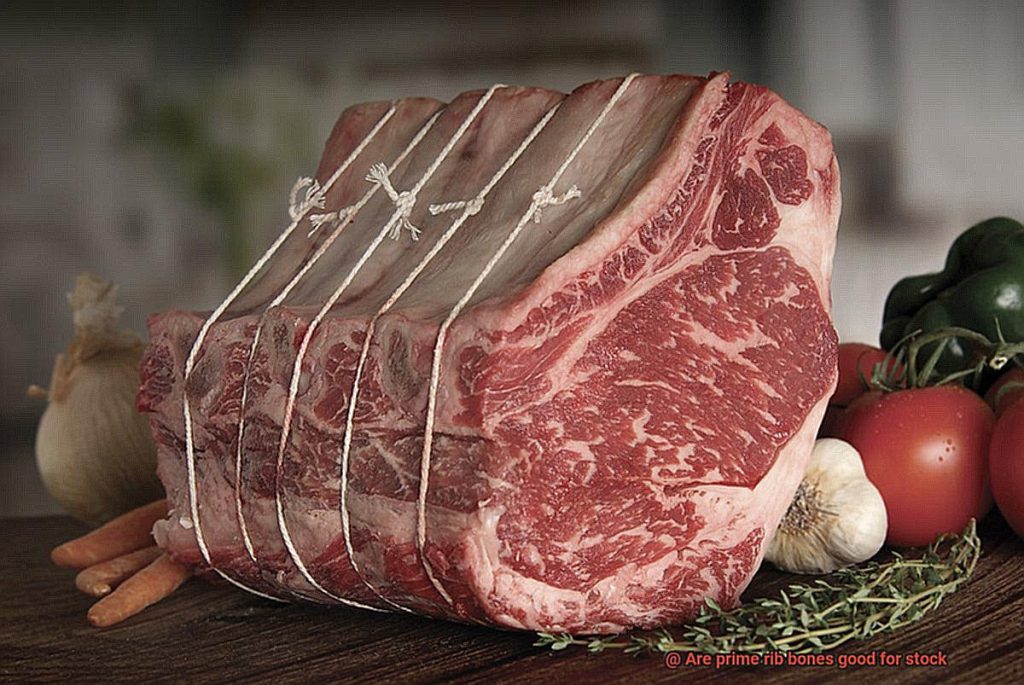Winter is here, and with it comes the craving for warm and hearty soups and stews. But what’s the secret to making a truly delicious homemade stock? It all starts with the bones, and prime rib bones are a hidden gem that many people overlook.
Prime rib is a beloved cut of beef, known for its tender texture, rich flavor, and beautiful marbling. But what happens to those leftover bones after you’ve savored every last bite of your meal? Too often they end up in the trash, when they could be used to create a stock that’s bursting with flavor and nutrients.
In this article, we’ll dive into why prime rib bones are ideal for making stock. We’ll explore the nutritional benefits that can be found in these bones, as well as provide step-by-step instructions on how to turn them into a comforting broth that will warm you from head to toe during these chilly months.
So next time you’re enjoying a juicy prime rib dinner, don’t toss those bones. Instead, use them to create a nourishing stock that will keep you cozy all winter long.
Contents
What Are Prime Rib Bones?
Prime rib bones are a culinary treasure that should not be overlooked. These bones are the remnants of a prime rib roast and are highly prized for their rich flavor and tender texture. When simmered properly, prime rib bones release gelatin into the broth, which gives the stock a luscious and velvety mouthfeel.
If you’re planning on using prime rib bones to make stock, here are some key tips to keep in mind:
- Choose bones with plenty of meat still attached for maximum flavor and richness.
- Trim excess fat before using in your stock to prevent it from becoming greasy and unappetizing.
- Use bones that have not been previously cooked to ensure the best possible flavor.
Prime rib is a cut of beef that is beloved by many for its marbling, tenderness, and savory flavor. After the prime rib has been cooked and enjoyed, there are often leftover bones that can be used to make stock. Prime rib bones are typically large and contain lots of meat and fat, making them an ideal choice for creating beef stock.
When selecting prime rib bones for your stock, take care to choose ones with plenty of meat still attached. This will give your broth an extra boost of flavor and richness. However, be mindful not to add too much fat to your stock, as this can result in a less than desirable texture.
Benefits of Using Prime Rib Bones for Stock
Consider using prime rib bones for a richer, more flavorful stock that offers a range of benefits.
Let’s explore some of the key benefits of using prime rib bones for stock:
- More connective tissue and flavor: Prime rib bones are larger and meatier than other types of bones, providing more connective tissue and flavor to your stock. This results in a more complex and robust taste that can be used in a variety of dishes.
- Nutritional value: Prime rib bones contain marrow, which is packed with vitamins and minerals like iron, zinc, and calcium. The healthy fats in marrow also improve the texture and mouthfeel of the stock, making it extra satisfying.
- Easy to find: Prime rib bones are a popular cut of meat for home cooks, meaning they’re easy to find at most grocery stores and butcher shops. Plus, they’re relatively affordable compared to other cuts of meat.
- Sustainable and cost-effective: By using prime rib bones for stock, you’re making use of a part of the animal that might otherwise go to waste. Simmering the bones slowly over low heat extracts as much flavor and nutrition as possible, making this an eco-friendly and cost-effective way to create delicious homemade stock.
To get the best possible flavor from your prime rib bones, choose those with meat still attached and trim excess fat. Additionally, avoid using bones that have been previously cooked to maximize their connective tissue and flavor potential.
Selecting the Right Prime Rib Bones

It’s time to get serious about selecting the perfect prime rib bones for your stock. The bones you choose will make all the difference in the flavor and quality of your stock, so pay attention to these expert tips.
First and foremost, look for bones that are well marbled with fat. This fat is where all the good stuff comes from – it will melt during the cooking process, infusing your stock with rich, beefy flavor. Plus, the fat will help thicken your stock and give it a silky texture that will have you licking your spoon.
Next, consider the age of the beef. While younger beef may be more tender, older beef has more flavor and a richer mouthfeel. For the best results, look for prime rib bones from beef that is at least three years old. This will give your stock that deep, complex flavor that will make your taste buds sing.
Lastly, don’t skimp on quality. Look for prime or choice grade beef – these cuts will have the most flavor and tenderness. Don’t settle for lower grades of beef that might be tough or lacking in flavor. You deserve the best, and so does your stock.
Removing Meat from the Bones
Firstly, it’s essential to source high-quality prime rib bones for the richest and most flavorful stock. Once you have your bones, start by trimming off any excess fat or connective tissue. This step is crucial as it can impact the texture and taste of the final product.
Now it’s time to get down to business. With a sharp knife in hand, carefully cut away as much meat as possible from the bones. It’s important to be thorough in this step to avoid any remaining meat causing cloudiness and greasiness in your stock.
Why choose prime rib bones? These bones are packed with collagen, which gives your stock a smooth texture and creates a gelatinous consistency when cooled. Perfect for soups, stews, and sauces.
Adding Fat to the Stock
Get ready to take your prime rib bone stock to new heights with the addition of one key ingredient: fat. Adding fat to your stock can enhance its flavor and texture, creating a rich, velvety mouthfeel that will elevate any dish from good to great.
But not all fats are created equal. For the best results, use high-quality fat from prime rib bones. These bones are a great source of flavorful fat that can be used to make a delicious stock. However, be sure to remove any excess fat as too much can make the stock greasy and unappetizing.
So how do you add this magical ingredient? One method is to use the drippings from roasting your prime rib. Simply reserve the excess fat and add it to your stock during cooking or as a finishing touch for extra flavor and richness. Don’t stop there though, other sources of fat like chicken or beef can be used too, creating a more complex and nuanced final product.
Why bother adding fat at all? Fat is a carrier for flavors, allowing other ingredients to shine, while also providing that silky smooth texture we all know and love. In short, adding fat to your prime rib bone stock can help bring out its true potential.
Tips for Making a Delicious Stock with Prime Rib Bones
If you’re a fan of prime rib, you know that the bones are often the best part. But did you know that they can also be used to make a rich and flavorful stock? Follow these tips and tricks for making a delicious stock with prime rib bones that will take your cooking game to the next level.
To start, roast the bones in the oven to bring out their natural flavors and create a deeper, more complex taste. This step is crucial for creating a truly delicious stock. Once the bones are browned, add fresh herbs and vegetables like onions, carrots, and celery to infuse the stock with their flavors and aromas.
The key to making a flavorful stock with prime rib bones is to simmer it slowly over low heat for at least 6-8 hours. This allows the collagen in the bones to break down and create a rich, satisfying broth. As it simmers, skim off any impurities or fat that rise to the surface. This will ensure that your stock is clear and clean-tasting.
Classic Beef Stock Recipe with Prime Rib Bones
If you’re looking for a way to add depth and richness to your dishes, a classic beef stock recipe made with prime rib bones is the perfect choice. The larger, meatier bones contain more collagen and marrow, which results in a velvety texture and complex flavor profile.
To start, preheat your oven and roast the prime rib bones until they’re caramelized and browned. This step is crucial for developing the deep and complex flavors that make this beef stock so delicious. Once the bones are roasted, add them to a large stockpot along with vegetables like onions, carrots, and celery, as well as herbs like thyme and bay leaves.
Cover everything with water and bring it to a boil, then skim off any foam or impurities that rise to the surface. Reduce the heat to a low simmer and let the mixture cook for several hours. As it simmers, the bones will release their collagen and marrow, infusing the broth with rich flavor and a velvety texture.
The slow cooking process extracts all of the rich flavors from the bones and vegetables, creating a deeply flavorful broth that can be used immediately in soups or stews, or stored in the refrigerator or freezer for later use.
After several hours of simmering, strain the stock through a fine mesh strainer or cheesecloth to remove any solids. The resulting broth should be clear and clean-tasting with a rich and deep flavor profile.
Now that you’ve mastered the art of making beef stock with prime rib bones, it’s time to put it to use. Here are some additional ideas:
- Use it as a base for French onion soup
- Add it to your favorite beef stew recipe
- Make a classic pot roast with tender chunks of meat cooked in the beef stock
- Use it to deglaze your pan after searing a steak or roast for extra flavor
Experimenting with New Recipes Using Prime Rib Bones
Fear not, foodies. As an expert in experimenting with new recipes using prime rib bones, I’m here to share some tantalizing tips and tricks on how to make the most out of these culinary gems.
Let’s start with the classic recipe of making beef stock. Roasting the bones in the oven until they’re browned and caramelized is the first step to create a rich and full-bodied broth. Add onions, carrots, celery, and other aromatics of your choice to the pot before simmering for several hours. The result is a delicious beef stock that can be used as a base for various dishes, such as French onion soup or a hearty beef stew. You can even use it to make a delectable gravy to accompany your prime rib roast.
Now, let’s talk about bone broth, which is another exciting way to experiment with prime rib bones. After roasting the bones as before, add flavorful ingredients like garlic, ginger, turmeric, and lemongrass to your pot. Then, simmer for 12-24 hours to create a broth that is nutritious and packed with beneficial nutrients like collagen and amino acids. This comforting broth is perfect for sipping on its own or as a base for soups and stews.
63rxhjVZ9UI” >
Conclusion
In conclusion, prime rib bones are a culinary treasure that many underestimate when it comes to making exceptional homemade stock. These bones boast a delectable flavor and tender texture, making them the perfect choice for producing beef stock. When picking prime rib bones for your stock, be sure to select those with an ample amount of meat still attached and trim off any excess fat before use.
Using prime rib bones for stock provides numerous advantages, including more connective tissue and flavor, nutritional value from the marrow’s vitamins and minerals, easy accessibility at most grocery stores and butcher shops, and sustainability by utilizing a portion of the animal that might otherwise go to waste.
To create the best possible stock with prime rib bones, roast them in the oven until they’re caramelized and browned before simmering slowly over low heat for several hours. This allows the collagen in the bones to break down and produce a rich, satisfying broth. During cooking, skim off any impurities or fat that rise to the surface to ensure that your stock is clear and has a fresh taste.
With these tips in mind, you can explore new recipes using prime rib bones such as French onion soup or bone broth loaded with beneficial nutrients like collagen and amino acids.





